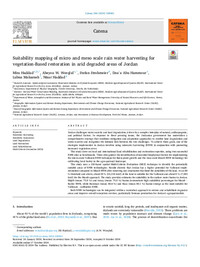Suitability mapping of micro and meso scale rain water harvesting for vegetation-Based restoration in arid degraded areas of Jordan

Authors:
Jordan challenges water scarcity and land degradation, driven by a complex interplay of natural, anthropogenic, and political factors. In response to these pressing issues, the Jordanian government has undertaken a comprehensive strategy that combines mitigation and adaptation approaches to combat land degradation and water scarcity and recognizes the intrinsic link between the two challenges. To achieve these goals, one of the strategies implemented in Jordan involves using rainwater harvesting (RWH) in conjunction with promoting increased vegetation cover.
This study drew on local and international land rehabilitation and restoration expertise, using two successful RWH sites as benchmarks. These sites guided the identification of essential biophysical factors for implementing the micro-scale Vallerani RWH technique for Badia plant growth and the meso-scale Marab RWH technology for cultivating local barley in the agro-pastoral landscape.
This study uses a GIS-based spatial Multi-Criteria Evaluation (MCE) technique to identify the potentially suitable areas of RWH technologies. Results showed that Jordan has a higher potential for Vallerani implementation compared to Marab RWH after removing any constraints that limit the suitability of the land. At an 80 % threshold and above, about 29 % (23,316 km2) of the land is suitable for the Vallerani and about 9 % (7,583 km2) for the Marab approach. The study provides estimates for suitability in the surface water basins in Jordan. Mujib (mean: 75.8 %) and Azraq (mean: 75.0 %) basins demonstrate high suitability percentages for Marab – Barley RWH, while Hammad (mean: 80.6 %) and Hasa (mean: 80.1 %) basins emerge as the most suitable for Vallerani – saltbushes RWH.
Both RWH technologies can be integrated within a watershed approach to restore and rehabilitate degraded areas and improve overall ecosystem services, particularly biomass production for Jordan’s agropastoralists.
